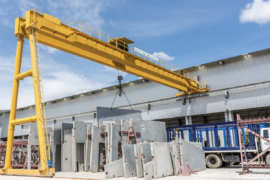This article may contain references to products or services from one or more of our advertisers or partners. We may receive compensation when you click on links to those products or services. Nonetheless, our opinions are our own.
With consumers aware of clean energy possibilities, government tax credits, and a desperate desire for renewable energy solutions, the solar energy sector is booming. However, as solar firms grow and branch out into different paths, they need digital content, educational development, and promotional support. The solution doesn’t come from an outdated content management system. In a sector that relies on constant change, a standardized, out-of-touch content management system does not supply the demand. Thus, growth and expansion become harder to achieve.
Enter the Headless CMS, the content management system of tomorrow that enables solar companies to make adjustments on the fly, create a customized experience, and publish content across multiple digital channels rapidly. A Headless CMS separates content from a front-end display, allowing solar companies to simplify the creation and publishing process while enhancing customer engagement. Therefore, it is the recession-proof marketing solution for years to come. This article explains why a Headless CMS is essential for solar companies to keep up with scalable, sustainable digital marketing efforts to stay relevant in this ever-competing green world. As well as how you can future-proof your content with headless CMS.
- Scaling Content Across Multiple Digital Channels
- Improving SEO and Search Visibility for Solar Companies
- Delivering Personalized Content for Consumer Engagement
- Reducing Marketing Costs and Operational Overhead
- Supporting Sustainability Goals with Digital Efficiency
- Enabling Faster Website Performance for a Better User Experience
- Ensuring Data Security and Compliance for Solar Businesses
- Supporting Omnichannel Marketing Strategies for Greater Reach
- Conclusion
- Recommended Reads
Scaling Content Across Multiple Digital Channels
Solar energy providers need to access their customers everywhere digitally, old and new, web and application, social media and e-newsletters, smart energy IoT devices. This is another shortcoming of the antiquated CMS; when content exists everywhere digitally, providers must go to all of those places to make the same content change manually. It’s monotonous and not a long-term solution. A Headless CMS offers a solution to this problem. A Headless CMS is content management in one location, and the enterprise creates that content one time and leverages APIs to deploy it in real-time across channels.
When a consumer is reading about solar panels on the enterprise website, receiving energy-saving tips from the enterprise app, or interacting with a social media bot, a Headless CMS affords them the same pertinent, real-time information. Solar companies, for example. If a solar company wants to highlight that it knows about a federal tax credit for solar installation, everything related to that piece of information can be pushed to a Headless CMS, which automatically updates all digital channels instead of having to go in and change everything everywhere at one time. Less time, less spent on marketing costs, and a seamless customer experience in all forms of engagement.
Improving SEO and Search Visibility for Solar Companies
SEO is important for your solar energy company because customers want to learn about you from A to Z. If someone searches for your solar energy company and it has a slow loading site, a confusing hierarchy of information, and is not mobile-friendly, your solar energy company gets pushed down on the page and doesn’t accumulate organic traffic. Headless CMS aids SEO in terms of loading speeds, meta tags, and loading hierarchies of information. Since a Headless CMS delivers information through APIs, it lowers backend stress, increases loading speeds, and appeases the work of bots.
All three are crucial factors in attempting to earn equity with Google. For instance, a solar eCommerce company selling solar panel kits can use a Headless CMS to arrange its product descriptions, tutorials, and review sections in such a way that Google quickly crawls (and ranks) them for more organic results and improved sales. In addition, many of the available Headless CMS have integrations with standard SEO plugins to gauge SEO performance metrics to pivot content strategy. A Headless CMS ensures solar companies can take advantage of having the most SEO-friendly setup online to generate more traffic search engines and potential customers.
Delivering Personalized Content for Consumer Engagement
Who buys from the solar energy market? Residential solar buyers, commercial solar buyers, solar for government buildings, and industrial energy consumption. Each segment needs different messaging, different content, and different value propositions. A CMS that does not change cannot offer those segmented experiences to the end user, which means content is generic and standardized. With a Headless CMS, solar companies can utilize dynamic content personalization so that varying customers see varying content based upon their geographical location, browsing habits, energy requirements, etc.
Moreover, integration with CRM systems and AI-based analytics enables such personalized suggestions as custom solar energy calculators, unique financing opportunities, and tax credits based upon geo-location. For example, a solar company with a national footprint can use a Headless CMS to render programmatic changes so that the user in California sees California tax credits and the user in Texas sees Texas net metering laws. Access to this information-based geo-targeted rendering boosts engagement, boosts conversions, and creates a more meaningful rapport with customers. Therefore, using a Headless CMS, solar companies can guarantee more targeted marketing efforts to ensure they get the information they need, when it needs to be gotten.
Reducing Marketing Costs and Operational Overhead
When content gets digitally replicated across platforms, it’s redundant and costly and time spent upgrading unnecessary content is time wasted. With old CMSs, there are always back-end changes needed, a dependency on developers, and sites that replicate content. Digital marketing becomes an expensive, time-intensive, resource-heavy endeavor. But with a Headless CMS, no updates are needed, and non-IT teams can find what they need in one place, minimizing dependence on IT to find other resources.
Marketing can adjust a promotion, change a landing page, or start a new campaign without needing a developer. Imagine a solar company hosting a brand new webinar on renewable energy policies. Using a Headless CMS, they can automatically adjust the copy and imagery everywhere it’s needed site-wide on the website, in the newsletter, and on social media pages. They don’t have to manually change it in three different places because it’s all integrated. The practicality of using a Headless CMS streamlines solar company operations for less time spent on content management and reduced digital marketing operational costs as efforts can be redirected to other brainstorming and implementation projects.
Supporting Sustainability Goals with Digital Efficiency
The web development company is a sustainability champion in its field. Therefore, it must employ energy-saving techniques in its construction. A conventional CMS solution requires extensive servers, duplicate files, and files that load/serve poorly, which ultimately requires additional energy for recycling. The conventional CMS solution creates a digital carbon footprint; the Headless CMS creates none through efficient caching, CDNs, and minimized API calls. This equates to faster load speed, which operates on less energy and more efficiently to maintain an online presence. For example, a solar company using a Headless CMS and bridging it to a static site generator like Next.js or Nuxt.js will have its quickly loading, low-energy site work in tandem with business goals.
Companies not dependent upon server-based, energy-sucking operations can more easily render online what their lower carbon footprint is and appeal to customers of a better, cleaner world. Thus, to host a Headless CMS to champion all things solar in the solar energy marketplace offers a clean digital solution that both helps branding goals and fosters reliability for clients who care about their carbon footprint.
Enabling Faster Website Performance for a Better User Experience
If your site takes too long to load, you’ll lose potential customers to another solar panel company. They want to check pricing, installation, and financing options right away before they seek any other solar panel solutions. Regular CMS websites are slow to load because of massive, avoidable database files, complex processing on the backend, and outdated caching. A Headless CMS alleviates this concern because it serves content through micro APIs and CDNs (Content Delivery Networks), which allow for easy loading of pages even on the busiest of days. This is imperative for solar energy customers who want fast access to information and need to learn about your company on the go.
For instance, a solar company may use a Headless CMS and a static site generator (SSG) such as Next.js. This solar company can pre-render pages that load in milliseconds for an optimal user experience. Furthermore, improved loading times equate to improved SEO assuming the solar company uses SEO titles and tags solar companies are found more readily online by customers. Therefore, using a Headless CMS for solar companies will mean a more consistent solar company website loading speed, reduced bounce rates, and an increased chance solar customers will engage with its content versus leaving because the site takes too long to load.
Ensuring Data Security and Compliance for Solar Businesses
As solar grows as an industry, companies have more vulnerable customer information, payment processing details, and regulatory compliance data. Unfortunately, the average CMS does nothing to protect it third-party plug-ins, outdated architectures, and centralized hosting environments put solar companies at avoidable risk. Enter the Headless CMS. Since the content repository is decoupled from the presentation layer, many points of attack are avoided, as hackers don’t have access to where the data lives. With API delivery for content, encryption, and role-based access, solar companies can safeguard all data without fear of exposure. For example, a solar lender requiring an online application to apply for a loan would benefit from legal and financial compliance through a Headless CMS because all content created and rendered can be done in a secure space without worries, since requests from potential users, loan requirements, and disclaimers are kept private and within legal, financial bounds.
In addition, a Headless CMS is GDPR and CCPA compliant, so solar companies with international or interstate operations can be assured that they have the proper disclaimers for legal confidentiality. Access limitations through authentication and API rate-limiting help companies keep this customer information safe while still being able to provide necessary information. When a Headless CMS incorporates security and compliance into the mix, solar energy companies benefit from customer trust, digital asset protection, and regulatory adherence.
Supporting Omnichannel Marketing Strategies for Greater Reach
The solar customer of the present engages with brands on the web, mobile, social media, intelligent home integrations, and face-to-face. A traditional CMS would not facilitate omnichannel marketing because brands would have to manually enter the content across all other channels to duplicate the same content which is an ineffective, highly time-consuming endeavor. A Headless CMS allows for an omnichannel approach because brands merely need to enter content once and through dynamic rendering have the same content automatically populate across channels and touchpoints.
Social posts, websites, chatbot engagements, and email communications can all house the same, most current information without brand effort. For example, a solar company with a new referral incentive can edit all sales text through a Headless CMS to its solar company website and application and any partnered third-party sites simultaneously. Everyone has access to the marketing push. What a Google Assistant, Alexa, or smartphone chatbot would say would match what the solar company website would show to consumers. Thus, solar companies can broaden their audience and establish brand synergy through engagement across multiple platforms when using a Headless CMS and following an omnichannel strategy.
Conclusion
For solar energy companies, a Headless CMS is a chance to develop digital marketing solutions in a green, sustainable manner. The benefits of a Headless CMS relative to development are ease of content creation and storage, better SEO, opportunities for personalization, and lower operating costs, giving solar companies the upper hand in a saturated marketplace. With more and more demand for clean energy and sustainable solutions, companies must ensure their digital footprint is aesthetically pleasing, informative, and omnichannel accessible.
A Headless CMS makes all digital marketing needs possible, adjustable, and analyzable in real-time. Moreover, a Headless CMS enhances sustainability with better site speed and reduced digital carbon footprints, among many brand equity factors within an eco-friendly universe. Thus, solar companies can enjoy all the advantages of a Headless CMS for digital marketing both present and future. A Headless CMS establishes a sustainable approach to online marketing with the potential for expandable growth and increased engagement.

Reviewed and edited by Albert Fang.
See a typo or want to suggest an edit/revision to the content? Use the comment form below for feedback.
At FangWallet, we value editorial integrity and open collaboration in curating quality content for readers to enjoy. Much appreciated for the assist.
Did you like our article and find it insightful? We encourage sharing the article link with family and friends to benefit as well - better yet, sharing on social media. Thank you for the support! 🍉
Article Title: Why Solar Energy Companies Need a Headless CMS for Scalable and Sustainable Digital Marketing
https://fangwallet.com/2025/02/19/why-solar-energy-companies-need-a-headless-cms-for-scalable-and-sustainable-digital-marketing/The FangWallet Promise
FangWallet is an editorially independent resource - founded on breaking down challenging financial concepts for anyone to understand since 2014. While we adhere to editorial integrity, note that this post may contain references to products from our partners.
The FangWallet promise is always to have your best interest in mind and be transparent and honest about the financial picture.
Become an Insider
Editorial Disclaimer: The editorial content on this page is not provided by any of the companies mentioned. The opinions expressed here are the author's alone.
The content of this website is for informational purposes only and does not represent investment advice, or an offer or solicitation to buy or sell any security, investment, or product. Investors are encouraged to do their own due diligence, and, if necessary, consult professional advising before making any investment decisions. Investing involves a high degree of risk, and financial losses may occur including the potential loss of principal.
Source Citation References:
+ Inspo












































